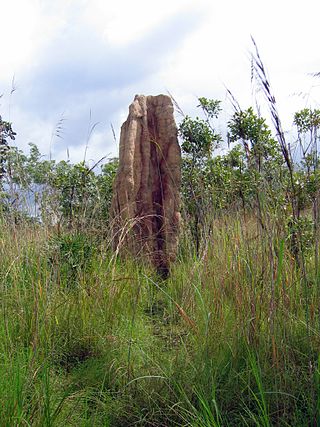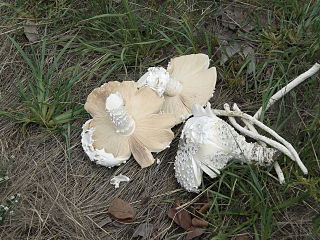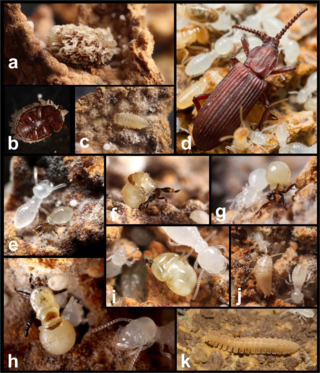
Termites are a group of detritophagous eusocial insects which consume a variety of decaying plant material, generally in the form of wood, leaf litter, and soil humus. They are distinguished by their moniliform antennae and the soft-bodied and often unpigmented worker caste for which they have been commonly termed "white ants"; however, they are not ants, to which they are only distantly related. About 2,972 extant species are currently described, 2,105 of which are members of the family Termitidae.

Leafcutter ants are fungus-growing ants that share the behaviour of cutting leaves which they carry back to their nests to farm fungus. Next to humans, leafcutter ants form some of the largest and most complex animal societies on Earth. In a few years, the central mound of their underground nests can grow to more than 30 m (98 ft) across, with smaller radiating mounds extending out to a radius of 80 m (260 ft), taking up 30 to 600 m2 and converted into 3.55 m individuals.

Fungus-growing ants comprise all the known fungus-growing ant species participating in ant–fungus mutualism. They are known for cutting grasses and leaves, carrying them to their colonies' nests, and using them to grow fungus on which they later feed.

Mound-building termites are a group of termite species that live in mounds which are made of a combination of soil, termite saliva and dung. These termites live in Africa, Australia and South America. The mounds sometimes have a diameter of 30 metres (98 ft). Most of the mounds are in well-drained areas. Termite mounds usually outlive the colonies themselves. If the inner tunnels of the nest are exposed it is usually dead. Sometimes other colonies, of the same or different species, occupy a mound after the original builders' deaths.

Ant–fungus mutualism is a symbiosis seen between certain ant and fungal species, in which ants actively cultivate fungus much like humans farm crops as a food source. There is only evidence of two instances in which this form of agriculture evolved in ants resulting in a dependence on fungi for food. These instances were the attine ants and some ants that are part of the Megalomyrmex genus. In some species, the ants and fungi are dependent on each other for survival. This type of codependency is prevalent among herbivores who rely on plant material for nutrition. The fungus’ ability to convert the plant material into a food source accessible to their host makes them the ideal partner. The leafcutter ant is a well-known example of this symbiosis. Leafcutter ants species can be found in southern South America up to the United States. However, ants are not the only ground-dwelling arthropods which have developed symbioses with fungi. A similar mutualism with fungi is also noted in termites within the subfamily Macrotermitinae which are widely distributed throughout the Old World tropics with the highest diversity in Africa.

Termitomyces, the termite mushrooms, is a genus of basidiomycete fungi belonging to the family Lyophyllaceae. All species in the genus are completely dependent on fungus-growing termites, the Macrotermitinae, to survive, and vice versa. They are the food source for these termites, who enjoy an obligate symbiosis with the genus similar to that between Atta ants and Attamyces mushrooms. Termitomyces mushrooms are edible, and are highly regarded for their flavor.

Fungivory or mycophagy is the process of organisms consuming fungi. Many different organisms have been recorded to gain their energy from consuming fungi, including birds, mammals, insects, plants, amoebas, gastropods, nematodes, bacteria and other fungi. Some of these, which only eat fungi, are called fungivores whereas others eat fungi as only part of their diet, being omnivores.

The Macrotermitinae, the fungus-growing termites, constitute a subfamily of the family Termitidae that is only found within the Old World tropics.

Macrotermes bellicosus is a species of Macrotermes. The queens are the largest amongst known termites, measuring about 4.2 inches (110 mm) long when physogastric. The workers average 0.14 in (3.6 mm) in length and soldiers are slightly larger. Bellicosus means "combative" in Latin. The species is a member of a genus indigenous to Africa and South-East Asia.

Termitomyces schimperi is a large mushroom associated with the termite species Macrotermes michaelseni. It grows in the northern part of Southern Africa, from northern Namibia up to Democratic Republic of Congo (DRC), eastwards to Malawi and Mozambique, and westwards to Ivory Coast.

Termitotrox cupido is a species of scarab beetle in the subfamily Termitotroginae. It was first described by Munetoshi Maruyama in 2012, having been discovered living inside a nest of the termite Hypotermes makhamensis in Cambodia. It is a tiny, blind and flightless insect.
Hypotermes makhamensis is a species of termite in the subfamily Macrotermitinae of the family Termitidae. It lives in dry evergreen forests in tropical south-eastern Asia and builds termite mounds in which it cultivates fungus for use as food.

Macrotermes michaelseni is a species of termite in the family Termitidae, found in sub-Saharan Africa. It is associated with the fungus Termitomyces schimperi.

Macrotermes is a genus of termites belonging to the subfamily Macrotermitinae and widely distributed throughout Africa and South-East Asia. Well-studied species include Macrotermes natalensis and M. bellicosus.

Social immunity is any antiparasite defence mounted for the benefit of individuals other than the actor. For parasites, the frequent contact, high population density and low genetic variability makes social groups of organisms a promising target for infection: this has driven the evolution of collective and cooperative anti-parasite mechanisms that both prevent the establishment of and reduce the damage of diseases among group members. Social immune mechanisms range from the prophylactic, such as burying beetles smearing their carcasses with antimicrobials or termites fumigating their nests with naphthalene, to the active defenses seen in the imprisoning of parasitic beetles by honeybees or by the miniature 'hitchhiking' leafcutter ants which travel on larger worker's leaves to fight off parasitoid flies. Whilst many specific social immune mechanisms had been studied in relative isolation, it was not until Sylvia Cremer et al.'s 2007 paper "Social Immunity" that the topic was seriously considered. Empirical and theoretical work in social immunity continues to reveal not only new mechanisms of protection but also implications for understanding of the evolution of group living and polyandry.

Termitomyces eurrhizus species of agaric fungus in the family Lyophyllaceae native to Pakistan, India, Sri Lanka, Burma, southwestern China and Malaysia. The fungus has a symbiotic relationship with termites, its mushrooms growing out of mounds after periods of rainfall. It is eaten in Malaysia and the Indian subcontinent.

Leucocoprinus gongylophorus is a fungus in the family Agaricaceae which is cultivated by certain leafcutter ants. Like other species of fungi cultivated by ants, L. gongylophorus produces gongylidia, nutrient-rich hyphal swellings upon which the ants feed. Production of mushrooms occurs only once ants abandon the nest. L. gongylophorus is farmed by leaf cutter ant species belonging to the genera Atta and Acromyrmex, amongst others.

Odontotermes is a termite genus belonging to subfamily Macrotermitinae, which is native to the Old World. They are most destructive in wooden homes, and are agricultural pests in the tropics and subtropics of Africa and Asia. It is the most diverse termite genus in Africa, with 78 species recorded.

Odontotermes obesus is a species of termite in the family Termitidae. It is native to tropical southwestern Asia. This termite cultivates a symbiotic fungus in a special chamber in the nest. Workers gather vegetable detritus which they bring back to the colony, chewing up the material to make a suitable substrate on which the fungus will grow.

Odontotermes formosanus is a species of fungus-growing termite in the family Termitidae. It is native to southeastern Asia and was first described from Taiwan. This termite cultivates a symbiotic fungus in a special chamber in the nest. Workers and soldiers gather vegetable detritus which they bring back to the colony, chewing the material to a pulp to make a suitable substrate on which to grow the fungus.


















